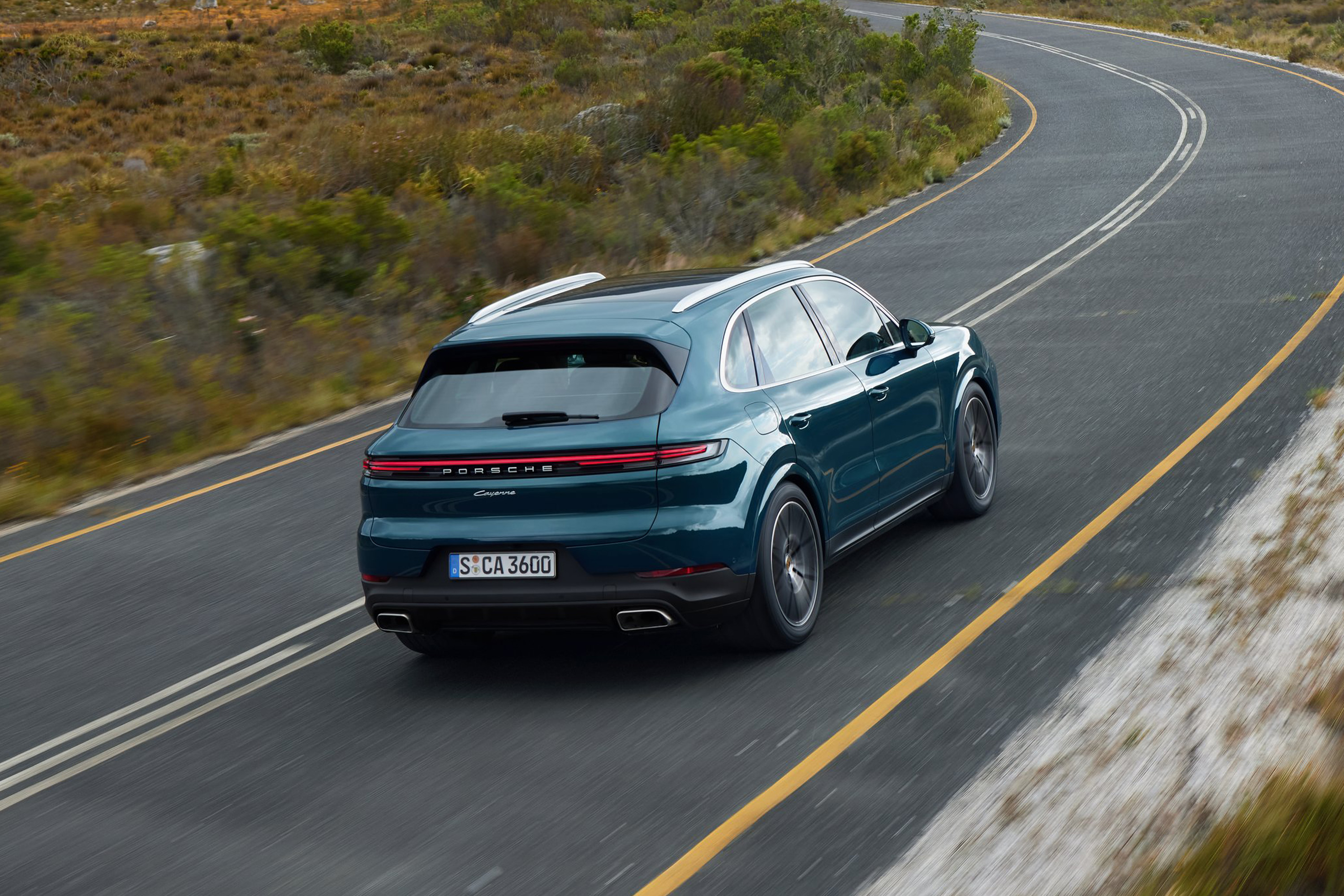It’s debatable whether it was the Porsche Cayenne or the Porsche Boxster that saved the brand from bankruptcy two decades ago. What’s not debatable is that when the Cayenne went on sale in 2002 it quickly became the company’s best seller. It remained that way until the compact and exceptional Macan debuted over a decade later.
The third-generation 2024 Porsche Cayenne was recently given a mid-cycle refresh. Changes include a new dashboard layout, like that of the Taycan with a passenger-side screen, a 12.6-inch digital instrument cluster, and several restyling modifications for the hood, headlights, bumpers, fenders and trunk.
Matrix LED headlights are now standard while the adaptive HD Matrix LEDs are optional in countries other than the U.S. as laws don’t allow them there yet. They have 32,000 pixels per headlamp, which can selectively dim for oncoming traffic.
The Cayenne looked sleek when it debuted in 2002 but has grown into an even handsomer, more chiseled two-row SUV. Of note, Porsche is one of the only automakers not offering something in the three-row size.
Porsche Cars North America

Porsche Cars North America
The powertrains were also upgraded. The base 3.0-liter six-cylinder now makes 348 horsepower (hp) and 368 pound-feet (lb-ft) of torque, which is 13 hp and 36 lb-ft more than before. The 4.0-liter twin-turbocharged V8 in this Cayenne S tester was also upgraded, now with a maximum output of 468 hp and 442 lb-ft of torque, 34 hp and 37 lb-ft more than its six-cylinder predecessor.
New shocks use two-valve technology for separate compression and rebound sections. Porsche says it improves the combination of ride comfort and handling.
The new V8 sounds angry (in a good way) both on startup and at full tilt. Shifts come early, often and gently from the eight-speed automatic with paddle shifters in Comfort driving mode. Sport lowers the vehicle and tightens the steering and suspension and the shifts get more forceful. Off-Road mode raises the vehicle significantly, for the rockier, bumpier, dirtier roads, and loosens up the suspension to ease the ride.
The Cayenne S is comfortable on those new shocks in Off-Road mode. It doesn’t bounce the driver all over in Sport mode either, which also has a Sport Plus notation in the central screen. Porsche (and other automakers) have widened the span of what an adaptable suspension can do. The aggressive tires are good both on and off road, and the brakes are sensitive. They feel smoother from high speeds, coming to a complete stop gently takes practice.

Porsche Cars North America

Porsche Cars North America
The multifunction steering wheel has a dial and a button for volume and for skipping forward in your track list. The gear selector in the now on the dashboard which makes room for storage and a large air conditioning panel, which doesn’t click unless your fingers actually hit a button. It must have some sort of sensor. A large volume knob is centered on the console.
The 12.6-inch curved digital instrument cluster joins the standard 12.3-inch central infotainment touchscreen with apps like Spotify and Apple Music. The passenger is now offered their own 10.9-inch display, which displays performance data, and allows access to the infotainment system controls and the option of streaming video content. Like many of these systems a special layer on the screen blocks the driver’s view.
The seating position is low for an SUV, which goes a long way to making it feel more planted and like a better handler. The seats are comfortable over hours of driving and very adjustable. Their cooling and heating functionalities can be engaged at the same, which is rare.
The rear area is fine, with plenty of space for two booster seats. The seatbelt latches were firm enough for the kids to buckle themselves in.
Safety systems include emergency braking, speed limit assist and traffic sign recognition. The optional adaptive cruise control has two new functions. Porsche’s Evasion Assist can steer an around emergency obstacle at speeds between 31 and 93 mph. Turn Assist monitors oncoming traffic when making a left hand turn.
The optional Porsche InnoDrive hands-on driver assist system has been improved with lane keeping and intersection assist.
The 2024 Porsche Cayenne starts at $80,850 while this Cayenne S comes in at $95,700 before destination and handling. The Genesis GV80 ($57,700), BMW X5 ($65,700) and Mercedes GLE ($63,800) and their variants are close competitors in performance, though not in price. However, the Porsche Cayenne still has genes spliced from the 911 coupe, meaning it feels a little bit lighter and handles a little bit better than all of them.
There might not be a 911 to buy today if the Cayenne wasn’t a success. That it eclipses most other SUVs in its class isn’t surprising, nor is it surprising when the 911 does it. Porsche knows what it’s doing.
Uncommon Knowledge
Newsweek is committed to challenging conventional wisdom and finding connections in the search for common ground.
Newsweek is committed to challenging conventional wisdom and finding connections in the search for common ground.















